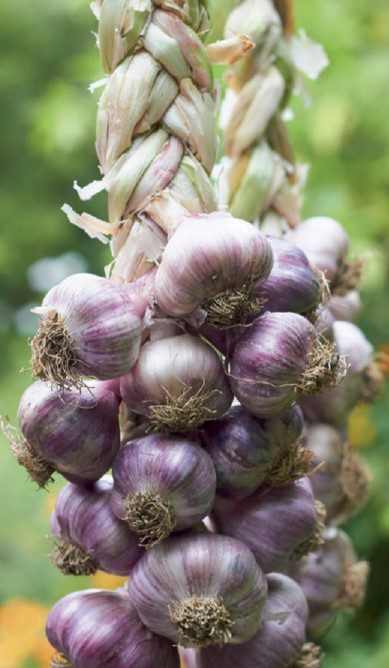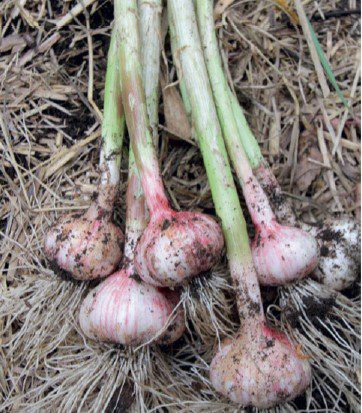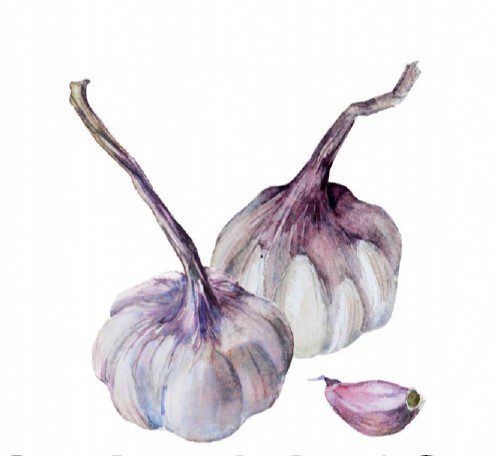Homegrown Garlic
During the lockdown, we all (very sensibly) became fascinated with growing our own food, and the food we most loved and asked about was?
Garlic! Homegrown garlic tastes dramatically better than shop-bought garlic, is used by nearly all cultures, in thousands of dishes, and it’s good for you too!
Among many roles, I am the head judge for garlic in the Australian Food Awards. Every year I am privileged to help judge the entries from garlic growers big and small from around Australia.
We look at quality and aroma and then taste every entry, both raw and roasted.
I am always amazed by the depth and variety of flavors, from complex to simple, searingly
hot to mild and sweet, and everything in between.
You can achieve these flavors by growing your own, or if that’s not possible, by buying Australian garlic.
Garlic (Allium sativum) originated in the remote mountainous gullies of central Asia.
Humans have cultivated and grown it for so long that it’s now almost impossible to collect true seed, so garlic is grown from its cloves, meaning every new plant is genetically identical to the plant it was grown from.
Garlic cultivars are divided into several groups. Knowing the Group will help you know what your garlic looks like, where it grows best, when to plant if it’s hardneck (grows a scape, umbel, and bulbils), or softneck (grows leaves).
Also, how long it stores and even something about the flavor and the best way of using that garlic.
Choosing garlic
To grow garlic, you plant garlic cloves. When starting your garlic adventure, it’s best to try different cultivars from different Groups for a few years and stick with those that do best in your soil and climate.
Buy only healthy bulbs from a reliable source. If possible, source grew garlic from farmer’s markets or online; it will already be adapted to your local climate.
Bulbs grown in a climate or soil very different from yours may take several years to adapt and do well.
Don’t grow from supermarkets or greengrocer bulbs as they are often treated with sprout inhibitors, such as maleic hydrazide, to stop them sprouting during storage.
Also, don’t plant imported bulbs as they’re all sprayed with the toxic biocide, methyl bromide, and may carry viruses not found in Australia.
The mantra to remember is ‘plant the best cloves from the best bulbs and eat the rest.
Climatic needs
Garlic grows from southern Queensland to Tasmania. It also does well in SA and WA from Geraldton to the South West.
Ideal regions have cool to cold winters and hot summers with low humidity. Temperatures between 5 and 10°C for 1–2 months in early growth stages (typical of temperate climates) will initiate bulb and clove formation.
If garlic is never exposed to temperatures below 20°C, then bulbs may not form, or you’ll get rounds with no cloves.
Garlic bulbs begin to swell as days get longer and temperatures increase. You can’t grow true garlic in the tropics because of high humidity. Also, the days aren’t long enough for bulb formation.
You can, though, grow elephant or Russian garlic (A. ampeloprasum), which is actually a leek.
It produces large bulbs with cloves, with a mild garlicky-leek flavor. All parts are edible.
Over recent years, we’ve seen garlic respond with growth anomalies to odd, extreme weather resulting from climate change, including sudden unexpected heavy rainfall, or an unusual plunge in temperature, or a scorching, early-season day.
These events have caused side sprouting where the outer leaves of a clove suddenly start growing.
Early extreme heat causes the whole plant to fall over (especially with Turban Group garlic), and quite recently, bulbs have been observed that don’t develop cloves but have layered clove skins with an amorphous mass in the middle.
Get the soil right
Garlic likes full sun and light, well-drained soil. Due to my heavy clay soil, I grow in raised beds about 30cm high.
Garlic likes a soil pH between 6 and 7, so if your soil is below 6, add a handful of lime for every square meter.
Garlic loves soils that are high in organic matter, so a minimum of three weeks before planting, add a horse, cow, or sheep manure (well-rotted or bought from a garden center), fishmeal, compost, or a combination of all of these.
Alternatively, at least eight weeks before, plant a green manure crop. Try broad beans, cowpeas, oats, lucerne, mustard, or soybeans, depending on your climate.
I also add some rock dust for trace elements. Finally, change the planting area each year to prevent fungal build-up in the soil on at least a three-year cycle.
When and how to plant
Plant cloves from late March to June, but exact timing depends on where you are and what cultivars you’re growing.
For example, in Queensland’s garlic region, optimum planting times are from late March to early May.
In mild, temperate regions, the winter is not too cold and the summer not too hot; the best time to plant is April and May.
In warmer regions, refrigerate garlic at close to 10°C for 2 or 3 weeks before planting. This encourages sprouting and helps with bulb and clove formation.
This isn’t necessary for colder regions—separate bulbs into cloves just before planting.
This is known as ‘cracking.’ Some growers soak cloves in seaweed solution (1 teaspoon seaweed extract in 1L water) overnight before planting to encourage quick root growth.
If there’s any suspicion of fungal problems, add a teaspoon of bicarbonate soda to kill spores.
Plant cloves pointy end up 15cm apart, in rows 15 to 30cm apart with the top about 2cm below the soil’s surface.
Firm soil down and water immediately. Garlic takes between 6 and 8 months to reach maturity; the warmer the region, the shorter the time needed.
Mulch, fertilizer, and water
Keep plants free of weeds by mulching. Anything from 2 to 10cm is fine as long as the mulch is fluffy and open.
Mulch also protects bulbs from extreme weather conditions, such as heat and frosts, but if you get long periods of heavy rain, pull it back and replace it once the soil dries a
bit.
Seagrass, lucerne hay, and sugar-cane waste all make good mulch. When green shoots appear, sprinkle a slow-release pelletized fertilizer or blood and bone over the soil’s top – a handful per square meter.
In spring, watering with fish emulsion, seaweed extract, or worm juice – alternating every 2 to 3 weeks – will help growth and plant resilience.
If older leaves and leaf tips start yellowing, this suggests nitrogen deficiency. Extra fish emulsion will help.
Full sun and regular water are essential when bulbs are swelling. Garlic roots can go down 60cm, so water deeply.
But wet leaves will encourage fungal problems; installing a drip system will ensure regular
water without wetting leaves.
Pots and Wicking Beds
Garlic can be grown in pots and wicking beds, but because roots will be more constrained, they’ll need more regular feeding, and bulbs won’t be as big.
If the soil in the wicking bed stays too wet, you may have fungal problems.
Pests and Diseases
Watch out for rust (Puccinia allii) and black aphids (Neotoxoptera formosana) in homegrown garlic. Rust first shows as small, white patches on leaves, followed by orange spores.
This fungus spreads with wind and is encouraged by temperatures between 12 and
20ºC.
Spray plants with potassium bicarbonate, or Bordeaux, or sulfur (available at garden centers).
Don’t plant alliums back into the same soil for at least 3 years.
To control black aphids, spray with vegetable-based soap spray, followed a week later with pest oil.
Make sure it gets into the leaf joints. Repeat if necessary.
GLOSSARY
Bolting: With garlic, used interchangeably with the term ‘top-setting,’ meaning the plant grows a scape, topped by an umbel containing bulbils.
Bulb: A plant storage organ. In garlic, this is made up of external skins, surrounding cloves which also have skins.
Bulbil: Small bulbs that usually grow in the umbel, sometimes found in the pseudostem.
Clove: A swollen leaf base with another leaf base that forms the skin. Each clove has the ability to grow into a new bulb.
Cure: A process where the garlic is allowed to dry out. Nutrients are absorbed from the leaves and stored in the bulbs.
Hardneck: Cultivars of garlic that produce scapes and umbels.
Pseudostem: Stems that are made up of elongated, tightly wrapped, overlapping leaf bases.
Scape: A leafless flower stalk that grows from basal leaves. In garlic, the umbel and bulbils grow from the top of the scape, not usually flowers.
Softneck: Cultivars of garlic that don’t usually produce a scape or umbel.
Umbel: The flowerhead that forms at the top of the scape usually containing bulbils. In some cultivars, there will also be a few flowers.
References:
- garlicaustralia.asn.au/find-a-grower-seller
- farmhousedirect.com.au/products/freshgarlicinseason
- diggers.com.au
- greenharvest.com.au tasmaniangourmetgarlic.com.au thelostseed.com.au
- theseedgarlicshop.com.au/#/



























Comments are closed.